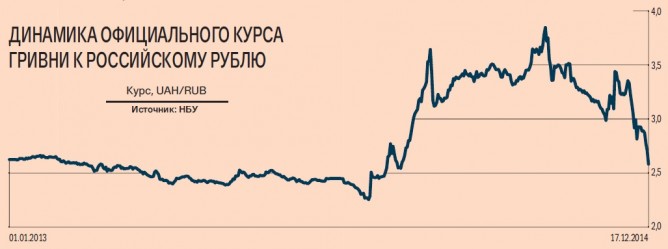Finance
currencyRussian ruble has pulled the hryvnia to rock bottom

All of last week the Russian ruble set new historic lows on the background of the collapse of prices for Brent oil from US $70 to US $60 per barrel since the start of the month. This week, however, despite that the prices for oil stopped sliding, the ruble continued hitting new lows. On Monday, during the trading at the Moscow Exchange, the U.S. dollar exceeded RUR 63.4/US $1. The Bank of Russia tried to snuff out the currency panic during the day through currency interventions and at night by sharply increasing the interest rate from 10.5% to 17%. Nonetheless, the ruble continued to slide on Tuesday and in the course of trading its value reached RUR 80.1/USD. By the close of trading the rate of the ruble rolled back a bit to RUR 72.50/USD, which is still RUR 12 higher than on the previous trading day. Yesterday, when the publication was sent to print the dollar rate was RUR 64.90/USD, having increased by 32% since the beginning of the month.
At first, Ukrainians openly gloated about the collapse of the ruble. However, in truth, this could also have painful consequences for the Ukrainian economy, which is still closely tied to Russia’s economy. The expectations of these consequences have already had an impact on the value of the Ukrainian currency.
Direct dependence
Ukraine’s economy still strongly depends on supplies to Russia despite that over the past year the Russian market has become less accessible for the export of Ukrainian commodities. In January-October Ukraine sold goods to Russia to the tune of US $8.8 bn, which is 19% of the country’s total commodity exports, according to the State Statistics Service. Meanwhile, preservation of oil prices at their current level and devaluation of the ruble pose a threat to the collapse of the entire Russian economy.
On Monday, Russia’s central bank announced stress scenario (now factually realized) for the Russian economy in 2015. According to its forecasts, the real GDP of Russia will fall 4.5-4.8% if the average annual price of oil remains at the current level of US $60 per barrel. “This will reduce Russia’s interest in trade with Ukraine,” says Director of the Institute of Economic Research and Policy Consultations Ihor Burakovskiy.
In addition to that, the dollar increased in value against the ruble by 98% since the start of the year, which is more than the dollar strengthened against the Ukrainian hryvnia. This means that the positions of Russian exporters on markets where Ukrainian products are being supplied will strengthen, said Burakovskiy. This primarily concerns exporters of grain, metallurgy and chemical products.
There is also a danger that now, when Russia is interested in proceeds in hard currency to the country, Moscow may be particularly insistent on pre-payment for gas supplies to Ukraine. As a reminder in June Gazprom suspended gas supplies to Ukraine. However, according to Brussels agreements, Naftogaz of Ukraine transferred to Gazprom the first tranche of US $1.45 bn on November 4 as payment of the gas debt, which opened a possibility for purchasing Russian gas until the end of the year on conditions of pre-payment. Within the framework of the agreements Naftogaz of Ukraine transferred to Gazprom an advance in the amount of US $378 mn on December 5 for supplies of 1 bn cu m of gas in December 2014.
Currency fever
Collapse of the ruble has already affected the hryvnia exchange rate. Over the same two days over which the ruble devaluated, the hryvnia renewed its historic low twice. On Monday, the rate of the Ukrainian national currency fell to UAH 17.60/USD by closing of the interbank exchange and on Tusday – to UAH 19.60/USD. The rate on the cash market reached UAH 20-22/USD. At that, the ruble devaluation practically fully compensated the hryvnia devaluation in terms of hryvnia/ruble exchange rate since the start of the year. The official hryvnia rate against the ruble yesterday returned to the level of March – RUR 2.58/UAH 1.00.
The psychological factor also played its role. The collapse of ruble once again reminded of the fundamental reasons of the weakness of the hryvnia, thus breaking the fragile stability of the rate of the Ukrainian currency at the level of UAH 16/USD, believes Chief of Debt Instruments on the Local Market Department at Concorde Capital Yuriy Tovstenko.
This, in particular, is about hryvnia emission in the amount of around UAH 159.3 bn based on the increase of T-bills in the portfolio of the National Bank of Ukraine since the start of the year and also the lack of inflow of hard currency proceeds to the country, particularly from exporters. In closing, the demand for currency in order to repay foreign debts, including those of Naftogaz for gas, and satisfying the demand of the people for hard currency is also a critical factor.







 of the agreement of syndication with Financial Times Limited are strictly prohibited. Use of materials which refers to France-Presse, Reuters, Interfax-Ukraine, Ukrainian News, UNIAN agencies is strictly prohibited. Materials marked
of the agreement of syndication with Financial Times Limited are strictly prohibited. Use of materials which refers to France-Presse, Reuters, Interfax-Ukraine, Ukrainian News, UNIAN agencies is strictly prohibited. Materials marked  are published as advertisements.
are published as advertisements.